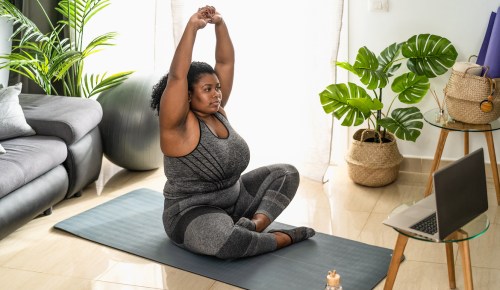Why You Should Keep Your Workouts Under 60 Minutes, According to Trainers
If you've ever wondered, how long should my workout be? Trainers have a clear answer: Under an hour to keep it consistent

Time is one resource we all wish we had more of. Hectic schedules filled with ever more responsibilities keep us busy with little time for self-care, let alone exercise. According to the Centers for Disease Control and Prevention, more than 60 percent of U.S. adults don’t get the recommended amount of physical activity for good health. And women are even more likely than men to be inactive.
Experts in This Article
certified personal trainer and fitness educator
certified personal trainer, exercise nutrition coach, and author at Garage Gym Reviews
When time is scarce, it’s tempting to skip our workouts. We typically think we need to exercise for at least 60 to 90 minutes, and that much time can feel nearly impossible to find on some days. But, the truth is, we might be better off capping off our workouts well before we hit an hour.
“Keeping your workouts under 60 minutes allows you to maintain your goals, feeling good both physically and mentally,” says ACE-certified personal trainer Shauna Donfeld. “Anywhere from 30 to 60 minutes of exercise five to six days a week is truly ideal.”
The surprising dangers of working out for more than 60 minutes
Working out longer than an hour can potentially cause more harm than good for many people. Unless you’re an endurance athlete who runs marathons or competes in triathlons, regularly pushing past 60 minutes can lead to overtraining syndrome (OTS), a condition that occurs when you don’t properly recover after repetitive, intense training sessions. Common symptoms include prolonged fatigue, irregular menstrual cycles, persistent muscle soreness, poor sleep quality, weakened immune system, digestive issues, lack of sex drive, and mood swings.
Rachel MacPherson, an ACE-certified personal trainer with Garage Gym Reviews, says you should keep your workouts under an hour if you check any of these boxes: If you’re new to working out, if you’re having a hard time sticking to your fitness routine, if you’re dieting, if you’re having issues like missed periods, fatigue, joint pain, frequent illness, or trouble sleeping. “If you experience these effects,” she says, “you could stress your body too much, causing hormonal disruptions and overtraining syndrome.”
Women in particular should be mindful of their workouts’ intensity and volume. When it comes to stress—whether physical or mental—women are more susceptible to hormonal issues from OTS, says a 2017 study published in BMC Sports Science, Medicine and Rehabilitation.
“Workouts, although excellent for stress relief, can also add stress to your body, especially if you work out for longer than 60 minutes,” says MacPherson. That’s because extra-long workouts can spike your cortisol levels. Although cortisol is a beneficial hormone in small amounts, if it causes your body to be in an elevated state of stress for too long, it can damage your health, says Kelsey Martin, a certified personal trainer with Life Time.
“Also, working out too long can start breaking down muscle tissue,” Martin adds. “Women already typically have a harder time building muscle compared to men due to their lower levels of testosterone.”
How long you should be working out instead
For optimal health and well-being, the CDC’s Physical Activity Guidelines for Americans recommends that healthy adults get at least 150 minutes of moderate-intensity or 75 minutes of vigorous-intensity aerobic physical activity per week (or any combination of the two), plus two days of strength-training activities. That may sound like a lot, but your time spent physically active doesn’t have to be done all at once. It’s best to break it down into smaller chunks by spreading it across five 30-minute sessions a week, for instance, and allowing your body plenty of time to rest and recover.
Keeping workouts in the 30- to 60-minute range can help you be more consistent. “You’ll be less stressed, less fatigued, and better able to handle your recovery needs,” says MacPherson. “If you work out most days of the week, this shorter time frame is perfect for still getting in plenty of activity while being better able to fit in your workouts.”
Even working in just 10 minutes of movement on jam-packed days can have major benefits, from your mood to your memory function.
Don’t forget the hours you’re not working out
Keeping your workouts a manageable length also gives you more time to focus on recovery between each session. “Hydration, electrolytes, nutrition, sleep, recovery, and physical stress all factor into the quality of your workouts,” says Denise Cervantes, an ACE and NASM-certified personal trainer with Herbalife. “So listen to your body, and make sure you’re warming up and cooling down properly.” Instead of pushing hard for more than an hour, keep your workout concise so you can spend more time giving your body what it needs to get the most out of the time you do spend working out.
According to a 2021 study published in Nutrients, post-exercise recovery is “vital for the balance between training stress and physical recovery…to maximize the adaptation from, and performance in, subsequent training sessions.”
Translation? Get your rest, sleep well, and don’t push yourself beyond your limits—especially on days when you’re not feeling it.










